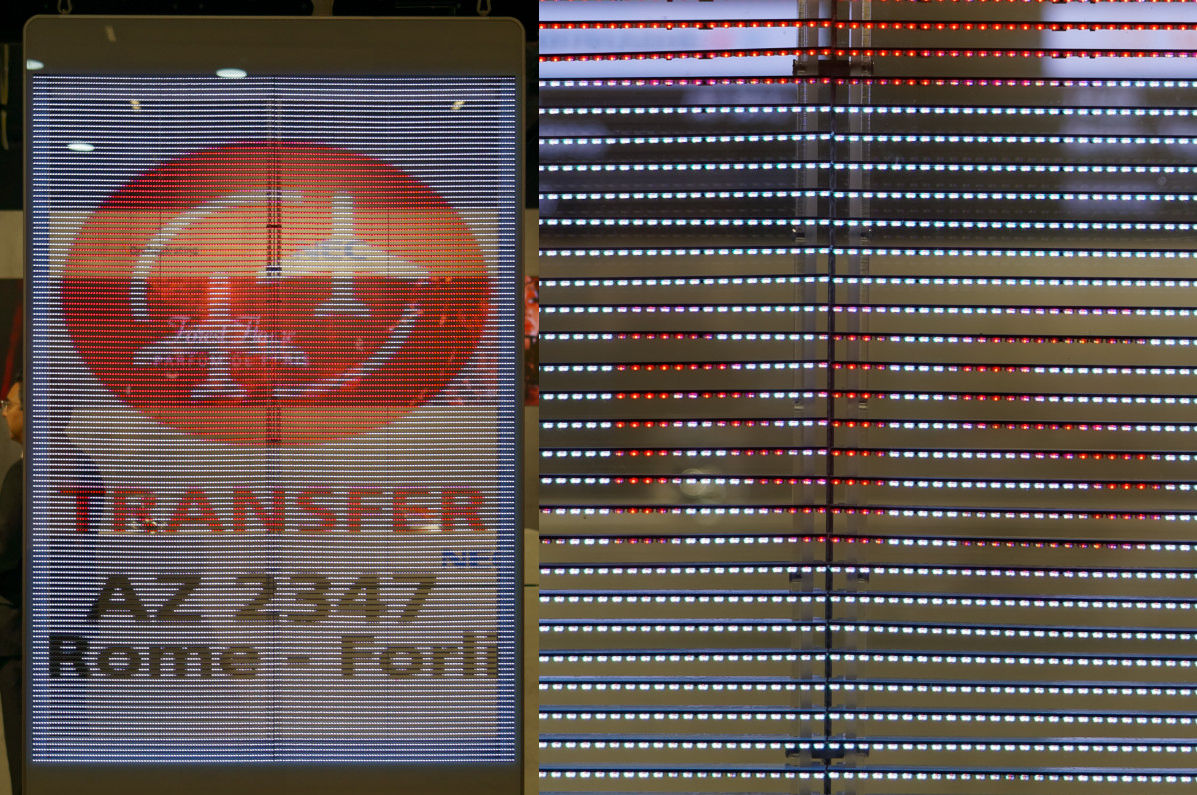 NEC has worked for a long time on the aviation market and has developed a strong business in recent years and Richard Wilks is the specialist who looks after the business as Business Development Manager.
NEC has worked for a long time on the aviation market and has developed a strong business in recent years and Richard Wilks is the specialist who looks after the business as Business Development Manager.
He has previously told us of the concept of ‘display surfaces’ in airports which NEC started to promote a couple of years ago. This concept works particularly well with LED and, of course, NEC has now acquired S-Quadrat to add to its capabilities in LED and that fits in with airports are going. LED is very flexible and long lasting and so is very popular with architects. That has meant that, increasingly, NEC is supplying LEDs into airports and at the show there was a demonstration of how they can even be used to create seamless displays check-in areas.
Wilks highlighted that check-in areas look very different these days, with self check-in and baggage check and will change again over the next few years (he expects a move to more emphasis on upgrade and extra sales – food etc – for airlines). It certainly seems unlikely that there will be less change so flexibility becomes critical.
Many airports are limited in their ability to physically expand (just consider the problems for Heathrow) and that means that for many operators the challenge is to get more throughput of passengers in the same space. To do that, you change how you manage the crowds. There has been a move away from large single flight information installations towards systems that divide larger numbers of passengers into smaller groups that can be directed efficiently.
For example, at Heathrow Terminal 3, there are three entrances but its not clear which door should be used, so passengers go into the nearest door, then get caught up in a lot of movement in the limited space inside. To solve this, the airport is looking at using LED displays outside the doors so that travellers get closer to their intended destination before they even enter the building. LED is also great in this application as it can be used for a variety of messaging including providing emergency information.
 NEC sees a lot of benefit from kerb side LEDs – Image:Meko
NEC sees a lot of benefit from kerb side LEDs – Image:Meko
The pressures on operators mean that NEC is doing a lot of work to show how good signage and displays can ease the ‘pressure points’ in airports. For example, airports know which airlines are flying to which destinations and therefore they can have a reasonable idea of the languages that may be appropriate for wayfinding and information provision. Digital signage is much more effective, then, than static.
In recent years, there has been a wave of building of new terminals in a line from Istanbul to Saudi Arabia as economies look to exploit the strategic geographic position between Europe and Asia. That wave has peaked now, with most terminals in building or complete. The centre of gravity of the industry has, therefore, moved more towards East Asia and China, where there is a lot of activity.
On to Products….
We expected, when we asked NEC if there was any new hardware to have to put ‘SOS’ in our notebook (Same Old Stuff, when we are being polite!). However, the company did have two ‘technology demos’ of new displays. The first is a ‘stretched LCD’ that has been developed for a transport application in Japan, so is available, but NEC is not sure if there is enough demand to justify putting it in the product line. It was showing it to get feedback.
 NEC is developing this E Ink display with Papercast – we probably should have taken an image of a timetable to highlight the resolution! Image:Meko
NEC is developing this E Ink display with Papercast – we probably should have taken an image of a timetable to highlight the resolution! Image:Meko
Also on display was a prototype 42″ E Ink display that is, by far, the largest that we have seen to date. The display has 2160 x 2880 resolution (640 x 860 mm) and has the usual E Ink virtue of using no power if there is light and the display doesn’t change (bistable). The display supports 16 grey scales and looked like a very good alternative for bus and train operators. The company has developed a front LED light that could be powered by battery for occasional use in the event of emergencies or lack of other light sources. Although this may not give as even a result as when illuminated by natural light, it means that the display can perform in an emergency. The display can have an ambient light sensor as an option.
The display concept includes connectivity which might be by 3G/4G/LTE, Wi-fi or Ethernet. The unit can run from 12V or a 12V rechargeable battery. Although the display itself doesn’t use any power, the communication system does – at the rate of 70mA without the LEDs and 200mA with.
NEC told us that it has a lot of interest in this kind of display as transport companies develop. It is developing the display in collaboration with Papercast of the UK.
(After I finished talking to NEC about the timetable E Ink display, I was thinking about the development of autonomous cars which could both compete with public transport or enhance it, depending how politicians and govermnents view the development of ride-sharing. Whatever happens, it’s the apps and information that Uber and Lyft provide that creates the service and public transport has to compete wih the level of information provided, or it will find itself relegated to an ‘also ran’ – BR)
The second display that was being shown was 42″ 1920 x 480 Stretched display which has been developed by NEC for a specific application with a Japanese railway operator. The company was showing the unit to customers in Europe to see if there is interest for specific products, although with the emphasis on LED in airports, these are more likely to be in other transport or retail areas, NEC thinks.
 NEC is unsure of the demand for this 42″ Stretch display. Image:Meko
NEC is unsure of the demand for this 42″ Stretch display. Image:Meko
We had a quick look around the other items on the booth and we talked about the new UltraHD display such as the P754Q 75″ unit which has a very good haze performance (acknowledged by one major competitor at the show) which reduces reflections and helps performance in difficult ambient conditions. The unit, which uses an IPS panel, has 650 cd/m² of output to help it compete in brighter ambient conditions. The unit should be available in June or July.
There was a new semi-transparent LED display, intended for applications such as shop windows and developed by S-Quadrat and which can be customised from the 3.9mm x 7.8mm configuration shown in Stockholm to 7.8mm square, 10mm square or 15mm square. Brightness of the modules, which are 500 x 1000mm, can be up to 5,500 cd/m². The units can be single or double sided and there have been projects in casinos although the most prestitigious public project, so far, has been for a Mercedes showroom in Berlin.
 NEC’s Semi transparent LED can be used in shop windows. The right hand side of the image is a close up. Image:Meko. Click for higher resolution.
NEC’s Semi transparent LED can be used in shop windows. The right hand side of the image is a close up. Image:Meko. Click for higher resolution.

